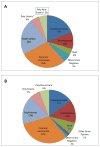Central line-associated bloodstream infections in neonates with gastrointestinal conditions: developing a candidate definition for mucosal barrier injury bloodstream infections
- PMID: 25333434
- PMCID: PMC4551075
- DOI: 10.1086/678410
Central line-associated bloodstream infections in neonates with gastrointestinal conditions: developing a candidate definition for mucosal barrier injury bloodstream infections
Abstract
Objective: To develop a candidate definition for central line-associated bloodstream infection (CLABSI) in neonates with presumed mucosal barrier injury due to gastrointestinal (MBI-GI) conditions and to evaluate epidemiology and microbiology of MBI-GI CLABSI in infants.
Design: Multicenter retrospective cohort study.
Setting: Neonatal intensive care units from 14 US children's hospitals and pediatric facilities.
Methods: A multidisciplinary focus group developed a candidate MBI-GI CLABSI definition based on presence of an MBI-GI condition, parenteral nutrition (PN) exposure, and an eligible enteric organism. CLABSI surveillance data from participating hospitals were supplemented by chart review to identify MBI-GI conditions and PN exposure.
Results: During 2009-2012, 410 CLABSIs occurred in 376 infants. MBI-GI conditions and PN exposure occurred in 149 (40%) and 324 (86%) of these 376 neonates, respectively. The distribution of pathogens was similar among neonates with versus without MBI-GI conditions and PN exposure. Fifty-nine (16%) of the 376 initial CLABSI episodes met the candidate MBI-GI CLABSI definition. Subsequent versus initial CLABSIs were more likely to be caused by an enteric organism (22 of 34 [65%] vs 151 of 376 [40%]; P = .009) and to meet the candidate MBI-GI CLABSI definition (19 of 34 [56%] vs 59 of 376 [16%]; P < .01).
Conclusions: While MBI-GI conditions and PN exposure were common, only 16% of initial CLABSIs met the candidate definition of MBI-GI CLABSI. The high proportion of MBI-GI CLABSIs among subsequent infections suggests that infants with MBI-GI CLABSI should be a population targeted for further surveillance and interventional research.
Conflict of interest statement
Figures


Similar articles
-
Mucosal barrier injury laboratory-confirmed bloodstream infection: results from a field test of a new National Healthcare Safety Network definition.Infect Control Hosp Epidemiol. 2013 Aug;34(8):769-76. doi: 10.1086/671281. Epub 2013 Jun 27. Infect Control Hosp Epidemiol. 2013. PMID: 23838215
-
The burden of mucosal barrier injury laboratory-confirmed bloodstream infection among hematology, oncology, and stem cell transplant patients.Infect Control Hosp Epidemiol. 2015 Feb;36(2):119-24. doi: 10.1017/ice.2014.38. Infect Control Hosp Epidemiol. 2015. PMID: 25632993
-
Impact of mucosal barrier injury laboratory-confirmed bloodstream infection (MBI-LCBI) on central line-associated bloodstream infections (CLABSIs) in department of hematology at single university hospital in Japan.J Infect Chemother. 2018 Jan;24(1):31-35. doi: 10.1016/j.jiac.2017.08.013. Epub 2017 Oct 21. J Infect Chemother. 2018. PMID: 29066217
-
Quality Improvement to Reduce Neonatal CLABSI: The Journey to Zero.Am J Perinatol. 2020 Sep;37(S 02):S14-S17. doi: 10.1055/s-0040-1713605. Epub 2020 Sep 8. Am J Perinatol. 2020. PMID: 32898877 Review.
-
Epidemiology of Infectious and Noninfectious Catheter Complications in Patients Receiving Home Parenteral Nutrition: A Systematic Review and Meta-Analysis.JPEN J Parenter Enteral Nutr. 2019 Sep;43(7):832-851. doi: 10.1002/jpen.1609. Epub 2019 Jun 6. JPEN J Parenter Enteral Nutr. 2019. PMID: 31172542
Cited by
-
Central Venous Catheter-Related Infectious Complications in Pediatric Surgical Patients: A Single-Center Experience.J Pediatr Intensive Care. 2021 Feb 17;11(3):240-246. doi: 10.1055/s-0041-1723946. eCollection 2022 Sep. J Pediatr Intensive Care. 2021. PMID: 35928034 Free PMC article.
References
-
- Bizzarro MJ, MD, Sabo B, APRN, Noonan M, RN, Bonfiglio MP, RN, Northrup V, MPH, Diefenbach K., MD A Quality Improvement Initiative to Reduce Central Line–Associated Bloodstream Infections in a Neonatal Intensive Care Unit. Infection control and hospital epidemiology: the official journal of the Society of Hospital Epidemiologists of America. 2010;31(3):241–248. doi: 10.1086/650448. - DOI - PubMed
Publication types
MeSH terms
Grants and funding
LinkOut - more resources
Full Text Sources
Other Literature Sources
Miscellaneous
